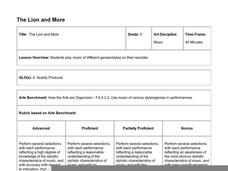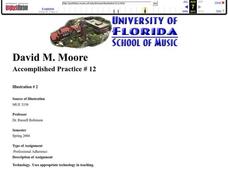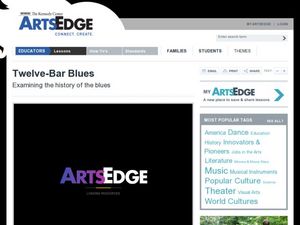North Carolina Standard Curriculum
Rhythm Counting
Understanding time signatures and rhythm counting are two very important parts of playing an instrument well. Here are three basic lessons rolled into one that prompt upper graders to play their instruments with care. They'll practice...
Curated OER
Using Rhythm Instruments to Tell a Story
After watching a video of Peter and the Wolf, and identifying the instruments used to represent each character, class members use rhythm instruments to represent the actions in the song, "What Would I do."
Curated OER
Rhythm Compositions
Fourth graders collaborate in small groups to create simple rhythmic patterns in different time signatures. Each group creates rhythms in a competitive "game" atmosphere and then constructs entire rhythmic groups for presentation to...
Curated OER
Identifying the Beat
Sixth graders listen to various songs. In this musical properties lesson, 6th graders work in groups to identify musical selections, practice tapping the beat, review time signatures, and identify the meter of different songs.
Curated OER
RHYTHMIC PATTERNS
Students explore rhythmic patterns. They create and perform the rhythms and use Cubase software to perform, record, and play rhythms for use in dictation exercises. They identify and count rhythm patterns
Curated OER
Rhythm Counting
High schoolers perform various rhythms and melodies in unison on their individual instruments. Assessment is performed on the last day of the lesson with each student playing individually for the class. This lesson meets national...
Curated OER
5 A Day
Students explore written music. In this cross-curriculum health and music instructional activity, students sing a "5 a Day" song about fruits and vegetables. Students clap a steady rhythm and identify written quarter notes in...
Concordia College Archives
History and Musical Aesthetics
What are the musical elements that characterize a school's fight song or its alma mater? Class members listen to examples of fight songs and alma maters from various schools, play a listening game, and then create a list of the...
Curated OER
It's Waltz Time!
Students, after hearing and viewing a video of the waltz scene from the musical, "Cinderella," by Mary Rodgers, "physicalize" a three beat rhythm with accompaniment video and discuss and evaluate triple meter. They master a song in 3/4...
Curated OER
Music Accomplished Practice #4
Second graders create their own rhythm with a time signature. They examine notes, rests, and how many beats for ech type of note. Students clap in rhythm. They perform their own rhythm for the class.
Hawaiʻi State Department of Education
The Lion and More
Melody, rhythm, tempo, and dynamics; get out those recorders it's time to play music! Your class will work on playing two lion-themed pieces that exemplify two different styles, folk and waltz. They'll discuss the elements of music and...
Curated OER
Sight-Reading Practice
Learners practice sight-reading skills in order to become more comfortable with them for future purposes. They review and drill on basic procedures for sight-reading for future competitions. Each student also analyzes advanced rhythms,...
Curated OER
Fats Waller, Handful of Keys
Playing piano is great fun and playing jazz is even better. Kids watch a video of Fats Waller playing the song, "Handful of Keys," they then use either a piano key print out or Orff instruments to practice his signature stride piano...
Curated OER
Creating, Notating and Recording an Original Song
Students are provided with a set of parameters, including theme, time
signature, number of measures, and form. Working within these parameters, the class , step by step, goes through the process of
creating, notating, and recording a...
Curated OER
First Rhythmic Composition
Young scholars apply fractions to counting rhythm in music. In this algebra lesson, students interrelate the concept of math into music as they fill out a chart identifying the names and symbols of music notes and their equivalent values...
Curated OER
A Round and A Round
Learners practice singing rounds in daily warm-ups for 2 weeks prior to beginning this composition lesson. Students incorporate movement to the rhythm of each syllable, discuss syllables of words and their relationship to note values and...
Curated OER
Music and Technology
Third graders practice reading rhythm patterns with different types of notes and meters. Using a counting system, they perform a sight reading exercise and take notes when needed. They use a form of technology to illustrate the music.
Curated OER
All About Me
Students examine who they are through the arts and sciences. They create a portfolio entitled, " All About Me."
Curated OER
Learning AB Form: Music
Third grade musicians play Orff instruments while they learn about the AB Form. First they learn part A of a song, then they listen to when the song changes. After they understand the concept of AB form, they learn to play part B. Note:...
Curated OER
Triple Meter
Students chant "Mabel, Mabel, Set the Table" in beats grouped in 4's using a percussive pattern. They repeat using 3's. Students sing a song in 4's and in 3's. they move to recorded music to practice threes. Students create Orff...
Curated OER
Spooky Notes
Second graders move to, sing, compose, and interpret various musical techniques through the use of "America", Tchaikovsky's "Waltz of the Flowers", and a song called "Skin and Bones". Emphasis is placed upon identifying names and values...
Curated OER
Twelve-Bar Blues
Students examine blues music. In this music genres lesson plan, students discover details about the history of the musical genre and compositional techniques. Students then compose melodies of their own with 12-bar blues chord progression.
Curated OER
Band On Line
In 1996, using the Internet to enhance learning was a new innovation. While the instructional activity here is a bit outdated, it could still provide a basic understanding of how technology can enhance music appreciation. Members of the...























